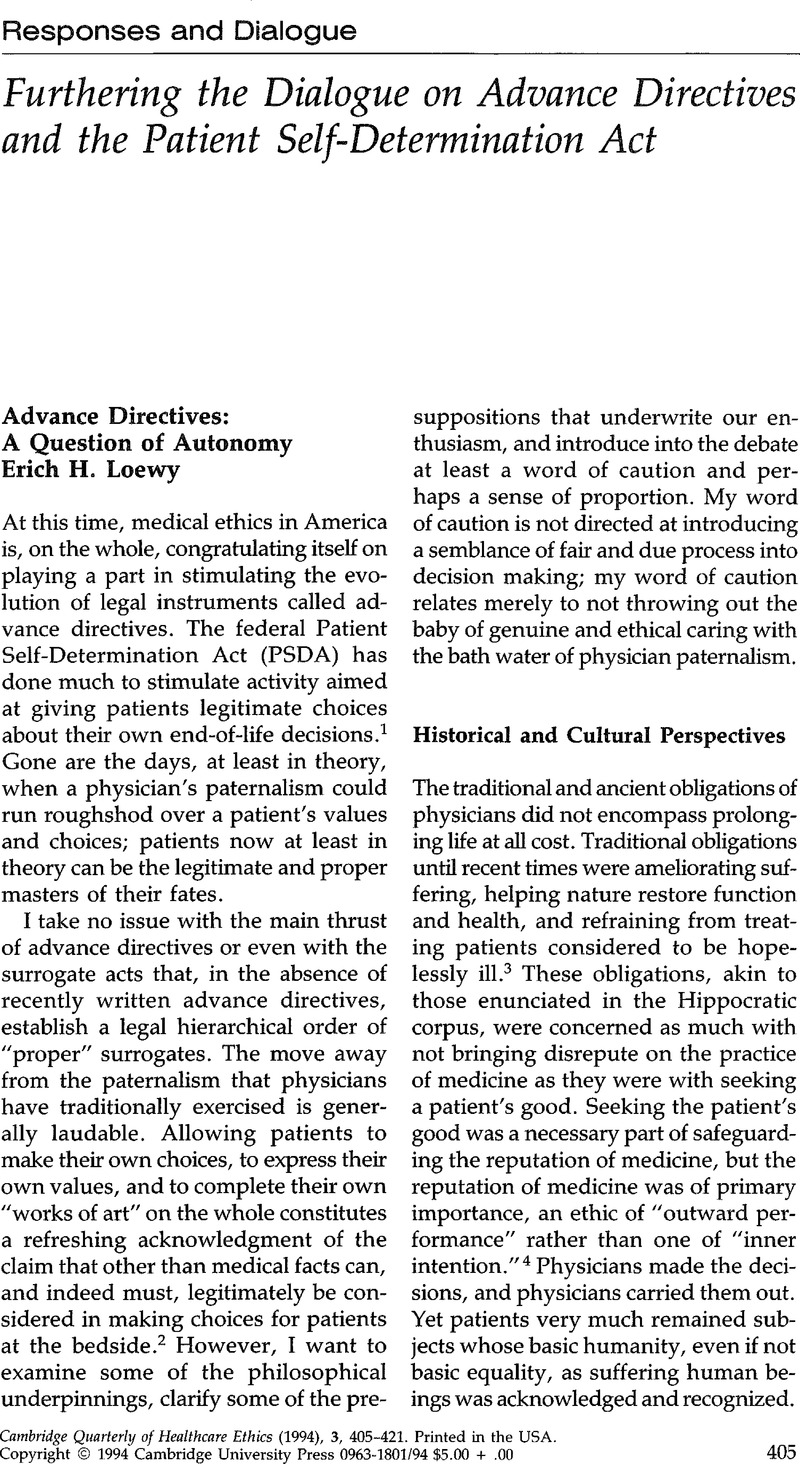Published online by Cambridge University Press: 29 July 2009

page 410 note 1. McCloskey, EL. Hopes for the PSDA. Journal of Clinical Ethics 1991;2:172–3.Google ScholarPubMed
page 410 note 2. Cassel, EJ. Life as a work of art. Hastings Center Report 1984;14:(5)35–7.CrossRefGoogle Scholar
page 410 note 3. Edelstein, L. The professional ethics of the Greek physician. Bulletin of Historical Medicine 1956;30:391–419.Google ScholarPubMed
page 410 note 4. Amundsen, DW. The physicians obligation to prolong life: a medical duty without classical roots. Journal of Historical Medicine 1977;32:403–21.Google Scholar
page 410 note 5. See note 4. Amundsen, . 1977;32:403–21.Google Scholar
page 410 note 6. Ackerknecht, EH. Rudolf Virchow. Madison: University of Wisconsin Press, 1953.Google Scholar
page 410 note 7. Terris, M. Concepts of social medicine. Social Services Review 1957;31:164–78.CrossRefGoogle Scholar
page 410 note 8. Engelhardt, HT. The Foundations of Bioethics. New York: Oxford University Press, 1986.Google Scholar
page 410 note 9. Engelhardt, HT. Bioethics and Secular Humanism. Philadelphia: Trinity Press International, 1991.Google Scholar
page 410 note 10. Engelhardt, HT. Morality for the medical industrial complex: a code of ethics for mass marketing of health care. New England Journal of Medicine 1988;319(16):1086–9.CrossRefGoogle ScholarPubMed
page 410 note 11. See note 8. Engelhardt, . 1986.Google Scholar
page 410 note 12. See note 10. Engelhardt, . 1988;319(16):1086–9.Google Scholar
page 410 note 13. Relman, AS. The new medical-industrial complex: a code of ethics for the mass marketing of health care. New England Journal of Medicine 1980;303(17):963–70.CrossRefGoogle Scholar
page 410 note 14. Nozick, R. Anarchy, State and Utopia. New York: Basic Books, 1974.Google Scholar
page 410 note 15. Cassel, EJ. The function of medicine. Hastings Center Report 1977;7(6): 16–9.CrossRefGoogle Scholar
page 410 note 16. Loewy, EH. Families, communities and making medical decisions. Journal of Clinical Ethics 1991;2:150–3.Google ScholarPubMed
page 410 note 17. Davidson, K, Hackler, C, Caradine, D, McCord, R: Physicians attitudes on advanced directives. Journal of the American Medical Association 1989;262:1415–19.Google Scholar
page 410 note 18. Pellegrino, ED, Thomasma, DC. For the Patient's Good: The Restoration of Beneficence in Health Care. New York: Oxford University Press, 1988.Google Scholar
page 410 note 19. Loewy, EH. Textbook of Medical Ethics. New York: Plenum, 1989.CrossRefGoogle Scholar
page 410 note 20. See note 9. Engelhardt, HT, 1991.Google Scholar
page 410 note 21. Kant, I. Kritik derReinen Vernunft. Frankfurt am Main: Suhrkamp, 1984.Google Scholar
page 410 note 22. Loewy, EH. The role of suffering and community in clinical ethics. Journal of Clinical Ethics 1991;2:83–9.Google ScholarPubMed
page 410 note 23. Loewy, EH. Suffering and the Beneficent Community: Beyond Libertarianism. Albany, New York: State University of New York Press, 1991.Google Scholar
page 410 note 24. Loewy, EH. Community, Communities and Suffering. Albany, New York: State University of New York Press, 1992.Google Scholar
page 410 note 25. See note 24. Loewy, . 1992.Google Scholar
page 410 note 26. See note 24. Loewy, . 1992.Google Scholar
page 410 note 27. Hardwig, J. What about the family? Hastings Center Report. 1990;19(2):5–10.CrossRefGoogle Scholar
page 410 note 28. Rousseau, JJ. Du Contrat Social (Grimsley, R., ed.). Oxford, England: Oxford University Press, 1972.Google Scholar
page 410 note 29. Rousseau, JJ. Discours sur l'Origine et les Fondaments de l'Inegalité parmi les Hommes. Paris: Gallimard, 1965.Google Scholar
page 416 note 1. Moreno, RM. American therapists speak out on patient's rights. In: Andrade, SJ, ed. Patient's Rights and Advocacy: For Hispanics? San Antonio, Texas: The Intercultural Development Research Association, 1981:50–65.Google Scholar
page 416 note 2. Garza, RT, Ames, RE Jr. A comparison of Chicanes and Anglos on locus of control. In: Hernandez, CA, Haug, MJ, Wagner, NN, eds. Chicanos: Social and Psychological Perspectives. St. Louis: C.V. Mosby Company, 1976:133–5.Google Scholar
page 417 note 3. Andrade, SJ. The vulnerability of Hispanic mental health clients: Can “patient rights” expand to address their needs? In: Andrade, SJ, ed. Patient's Rights and Advocacy: For Hispanics? San Antonio, Texas: The Intercultural Development Research Association, 1981:66–73.Google Scholar
page 419 note 1. Gorman, C. Why do blacks die young?. Time 1991 09 16:50;Google ScholarKjellstrand, C. Age, sex, and race inequality in renal transplantation. Archives of Internal Medicine 1988;148:1305;CrossRefGoogle ScholarPubMedKjellstrand, C, Logan, G. Racial, sexual, and age inequalities in chronic dialysis. Nephron 1987;45:257;CrossRefGoogle ScholarPubMedHeld, P, Pauly, M, Bovbjerg, R et al. , Access to kidney transplantation: has the United States eliminated income and racial differences? Archives of Internal Medicine 1988;148:2594.CrossRefGoogle ScholarPubMed
page 419 note 2. Byrd, M, Clayton, L. The “slave health deficit” racism and health outcomes. Health/PAC Bulletin 1991;25(Summer);Google ScholarSchwartz, E, Kofie, V, Rivo, M et al. , Black/white comparisons of deaths preventable by medical intervention: United States and the District of Columbia 1980–1986. International Journal of Epidemiology 1990;591;CrossRefGoogle ScholarPubMedByrd, M. Race, biology, and healthcare: reassessing a relationship. Journal of Healthcare for the Poor and Underserved 1990;(Winter):278.CrossRefGoogle ScholarPubMed
page 419 note 3. Escarce, J, Epstein, K, Colby, D et al. , Racial differences in the elderly's use of medical procedures and diagnostic tests. American Journal of Public Health 1993;(07):948.CrossRefGoogle ScholarPubMed
page 421 note 1. Lombardi, FG, Lombardi, GS. Life and death, the circle is timeless. In: Circle without End, a Sourcebook of American Indian Ethics. Naturegraph, 1982:36–9.Google Scholar
page 421 note 2. Klein, BT. Reference Encyclopedia of the American Indian. 6th ed.West Nyack, New York: Todd Publications, 1993.Google Scholar